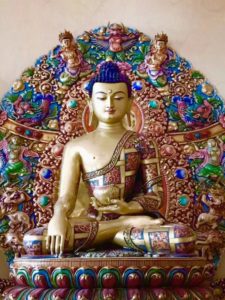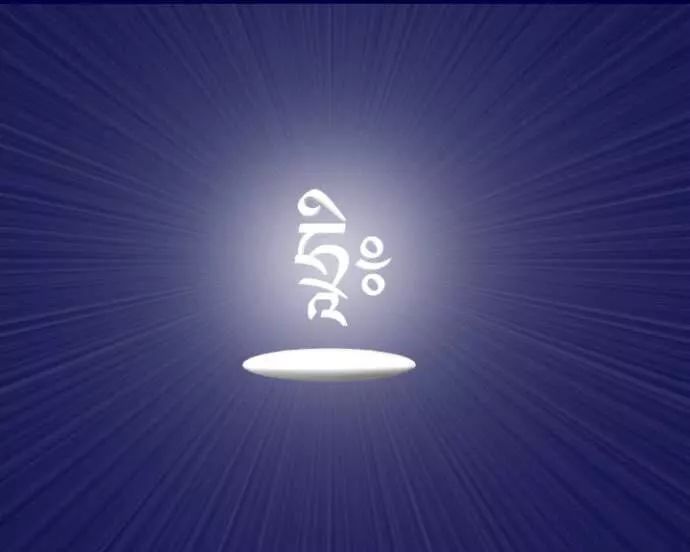
For Shamata practice, in the beginning, I would recommend visualizing a small Buddha, visualize it and meditate with it, without the chanting, without praying anything. Just simply focus your mind on the Buddha. Visualize from the top to the bottom, from the bottom to the top.
But in the beginning of the practice session, to make yourself calm down, you have to tell yourself that ‘Nothing in this world is important. Only the meditation state and way of discovering this meditation state, are important. And therefore the Shamata practice is very much needed.’ Try to hold on that thought and meditate a little bit, and say to yourself that ‘Everything is fine, everything is good, nothing is wrong, nothing is important. Therefore, I’ll keep my mind focus on that.’ Bring your mind to a complete silence.
And then when you have a little bit of disturbing thoughts, then try to visualize the Buddha. You put a small Buddha statue in front of you, or visualize a small Buddha in front. Then you focus, you meditate the Buddha from the top, from the crown, to the eyes, to the face, to the legs, to the joints, all the way to the hands, and feet with the lotus. And then from the lotus go all the way up. And then go all the way down. And then you meditate, keep your mind focus. Do like that several times.
And then if you feel your mind is not focused, then try to do some breathing exercise. Breathing exercise, means that you let the air in and out in a very natural way, not like pushing, but in a very natural way. And then you breathe in, breathe out. breath in, breath out. breath in, breath out…… Then you sit still. Do like that seven times, then you count that ONE. In the beginning maybe you can do only three times for a time. And then back to visualizing and meditation practice again.
Practicing Shamata is good. But at the same time, there are many practitioners who do a lot of visualization and Shamata practice but then they lose the foundation very fast. They would say ‘Oh, I do Shamata practice. My mind is very quiet. My mind is very still.’ And then everything becomes very much like ‘My mind’, I mean, by only focus on ‘My mind is quiet.’, you are no longer thinking about sentient beings, no longer thinking about compassion, no longer thinking about other things, as you are thinking about only be quiet with your mind. If you want to have a life style only focusing on that, it’s nothing wrong. But if you want to practice the Buddha Dharma, and then I would like to suggest you combine the Shamata practice with the Cheregzig practice.
You can visualize Cheregzig, not have to be with four arms, you can visualize Cheregzig with two arms. Two arms, very simple cloth, fair color skin, and then the right hand holding a vase, and the left hand holding a lotus. So you visualize like that.
Whenever we think about Cheregzig, we think about compassion. And that’s the image of Bodhisattva of Compassion. So, visualizing, focusing on the Cheregzig, at the same time chanting the mantra, at the same time meditating, and keep that in circle. That helps me very much, when I was in the retreat. Because sometimes in the Vajrayana practice, there are so many visualizations, so many prayers and so many noises. But when you do Cheregzig practice, it is very simple.
So, I visualize two-arms Cheregzig, I say ‘I want to benefit all the sentient beings and therefore I want to reach to the enlightenment, based on following your footsteps, and therefore I visualize you. I visualize and chant your mantra, and I think of you.’
So your body and speech and mind is fully focused. And then you visualize Cheregzig from the crown to the eyes, to the nose, all the way down to the feet and to the lotus. And from feet, and the lotus, the dress, the earrings, the bracelet, and the vase, the flower, and to the lips, the nose , the radiant, the compassionate face, and then all the way to the crown, to the head of Amitabha. You visualize, and you meditate. And then if that is not enough, then you could say that, ‘in order to benefit all the sentient beings, therefore I dedicate this mantra ‘Om Ma Ni Pad Me Hung……’
And then you tell yourself, ‘The chanting and visualizing is a great practice, at the same time I want to meditate, therefore in the state of Dharmakaya, Avalokiteshvara’s state of mind and my state of mind, they are equally the same. Therefore, by seeing no difference, I meditate. ‘
So you could start to do your practice like that.

Tip:
- I hope that you could find a quiet place when you do the practice. If you have a family or friends staying with you, then you should tell them ‘I’m going to do practice, would you please not interrupt me?’ If you have a clean and private room, then you could prepare a shrine, a very simple shrine with offerings. Then you practice, you meditate.
- I would suggest you do the practice in the morning before you eat breakfast, after you take a shower, wash your face and mouth and everything, you do 3 times prostrations. You make some offerings and then you sit down, and then you start your meditation. But some people are more active in the morning, while some people are more active in the evening. So you have to choose what is suitable to yourself due to your personal life style, and make it suitable to your daily life.
- When you are chanting the mantra, you should visualize the syllable in the heart of Cheregzig. If you could visualize all the syllables exactly, it is good. But for beginners, just focus on the HRIH, the main syllable. Not all the mantra. Focus on the one main syllable. White color, or you can also visualize it in silver color. Because it is bright like a silver.
- The lotus in the hand represents for compassion, the vase that is giving the nectar to all the sentient beings means compassion in action, it means practicing the compassion, not just visualizing or thinking about compassion, but actually giving with generosity, love, and respect, and with care of others and all the sentient beings. So that’s the main point.

Comments are closed.